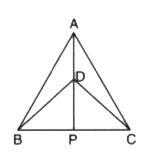The locus of vertices of all isosceles triangles having a common base.
To find the locus of the vertices of all isosceles triangles having a common base, we can follow these steps:
1. Identify the Common Base:
Let's denote the common base of the isosceles triangles as segment BC, where B and C are two fixed points in the plane.
2. Understanding the Isosceles Triangle:
An isosceles triangle has two sides that are equal in length. In our case, the vertices of the triangle will be denoted as A, and the base will be BC.
3. Positioning the Vertex A:
The vertex A of the isosceles triangle can be positioned anywhere above or below the line segment BC, as long as the lengths of AB and AC are equal.
4. Finding the Locus of Point A:
For point A to maintain the property of being the vertex of an isosceles triangle with base BC, it must be equidistant from points B and C. This means that the distance from A to B (AB) must equal the distance from A to C (AC).
5. Using the Perpendicular Bisector:
The locus of all points that are equidistant from two fixed points (B and C) is the perpendicular bisector of the line segment BC. This line will pass through the midpoint of BC and will be perpendicular to BC.
6. Conclusion:
Therefore, the locus of the vertices of all isosceles triangles having a common base BC is the perpendicular bisector of the segment BC.
Final Answer:
The locus of the vertices of all isosceles triangles having a common base BC is the perpendicular bisector of the segment BC.
Let's denote the common base of the isosceles triangles as segment BC, where B and C are two fixed points in the plane.
An isosceles triangle has two sides that are equal in length. In our case, the vertices of the triangle will be denoted as A, and the base will be BC.
The vertex A of the isosceles triangle can be positioned anywhere above or below the line segment BC, as long as the lengths of AB and AC are equal.
For point A to maintain the property of being the vertex of an isosceles triangle with base BC, it must be equidistant from points B and C. This means that the distance from A to B (AB) must equal the distance from A to C (AC).
The locus of all points that are equidistant from two fixed points (B and C) is the perpendicular bisector of the line segment BC. This line will pass through the midpoint of BC and will be perpendicular to BC.
Therefore, the locus of the vertices of all isosceles triangles having a common base BC is the perpendicular bisector of the segment BC.
The locus of the vertices of all isosceles triangles having a common base BC is the perpendicular bisector of the segment BC.
Topper's Solved these Questions
- BOOK - ICSECHAPTER - LOCI (LOCUS AND ITS CONSTRUCTIONS)EXERCISE - EXERCISE 16(A)26videos
LOCI (LOCUS AND ITS CONSTRUCTIONS)
- BOOK - ICSECHAPTER - LINEAR INEQUATIONSEXERCISE - Competency Based Questions15videos
LINEAR INEQUATIONS
- BOOK - ICSECHAPTER - MATHEMATICS -2014EXERCISE - SECTION- B29videos
MATHEMATICS -2014
Similar Questions
Sketch and describe the locus of the vertices of all triangles with a given base and a given altitude.
View SolutionShow that the bisector of vertical angle of an isosceles triangle bisects the base at right angles.
View SolutionFind the area of an isosceles triangle having the base x cm and one side y cm
View SolutionThe vertical angle of an isosceles triangle is 1000. Find its base angles.
View SolutionThe area of an isosceles triangle having base 2 cm and the length of one of the equal sides 4 cm is
View SolutionProve that the straight line joining the vertex of an isosceles triangle to any point in the base is smaller than either of the equal sides of the triangle.
View SolutionThe ratio between the base angle and the vertical angle of an isosceles triangle is 2:5. Find each angle of the triangle.
View SolutionThe vertical angle of an isosceles triangle is twice the sum if its base angles. Find each angle of the triangle.
View SolutionFind the area of an isosceles triangle having the base 6 cm and the length of each equal side 5 cm.
View SolutionThe given figure shows two isosceles triangles ABC and DBC with common base BC. AD is extended to intersect BC at point P. Show that:
ΔABD=ΔACD
(ii) ΔABP=ΔACP
(iii) AP bisects ∠BDC
(iv) AP is perpendicular bisector of BC.
 View Solution
View Solution
